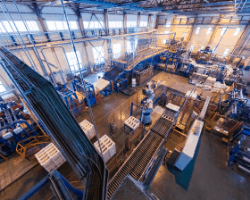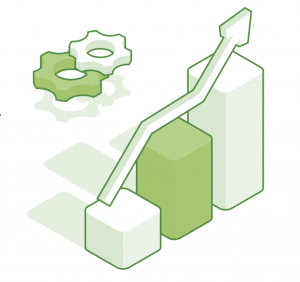
Manufacturers are eager to capitalize on the transformative promise that comes from digitizing operations. However, the motivations for moving to digital vary from company to company. Most advanced manufacturers aim to lower production costs, improve on-time delivery, estimate delays, and lower their quality risks.
Many also seek to improve their ability to predict machine or tool failure. Longer-term, manufacturers hope to adopt IIoT and Industry 4.0 to achieve cost reductions, improve efficiency, increase revenues, and offer a competitive differentiation.
A recent survey of 2,000 C-suite executives released by Deloitte found that 61 percent of those with Industry 4.0 strategies report they have developed innovative products and services, versus 12 percent of those lacking strategies. Another factor to consider is the impact of the COVID crisis. That same study found that 73 percent of companies with an Industry 4.0 strategy report success in protecting their businesses from disruption.
The problem is that many of the desired goals of Industry 4.0 are not within reach for most organizations. The reason: While the manufacturing sector generates a great amount of data by virtue of IoT devices embedded in equipment, only a few companies are harnessing the data to improve operational efficiencies.
Despite the strategic importance of digitalization, most initiatives fail to scale due to traditional connectivity architectures’ challenges. Traditional OT SCADA systems, which are used to manage manufacturing facilities and shop floors, have limited connectivity options. They were not designed for IoT scalability, resulting in siloed data from complex and mixed solutions on their factory floors.
Digital transformation projects have a better chance of success if efforts can be simplified and standardized. What’s needed is a scalable connectivity solution, quick and easy to implement, and able to connect the entire factory.
With such connectivity in place, the manufacturer can use that conduit to modernize their operations, improve product quality, and gain a competitive advantage over companies that maintain the status quo.
BENEFITS OF A UBIQUITOUS CONNECTIVITY SOLUTION
The modern factory floor and production lines are strewn with devices that produce data. Parts suppliers and machine vendors include sensors to monitor their equipment and systems, but their solutions are purpose-built for a very slim focus.
A connectivity solution that can bring such disparate data together offers many potential benefits. Any connectivity solution must:
Deliver the required performance: If the data is used for real-time monitoring, latency cannot be tolerated.
Be fast and easy to deploy: There cannot be disruptions or prolonged shutdowns for installation and fine-tuning.
Be highly scalable: The solution must support thousands to tens of thousands of devices (both brownfield and greenfield) that need connectivity within a factory, product plant, or facility.
A suitably selected solution can then be used to deliver a number of benefits.
Improve Asset Efficiency
Universally available connectivity can be used to realize greater asset utilization and return on assets (ROA), resulting in increased overall equipment effectiveness (OEE) and CapEx avoidance.

Lacking connectivity, insights into equipment or system performance would only be detected when a person physically visited the device and inspected it. Or worse, when the issue resulted in defective products coming off the line.
A connectivity solution could ensure such relevant data about assets is available in real-time and subject to analysis to spot problems in the making. Having access to the data would likely detect sub-optimal performance and allow actions to be taken to avert problems.
Connectivity provides additional benefits. Scalable, easy to implement, and pervasive connectivity can deliver data that can be used to increase asset efficiency by virtue of better managing work-in-progress inventory, reducing changeover delays, and making better use of under-utilized assets.
Reduce Operating Costs
Connectivity can be used to get more use out of installed equipment, assets, and staff.
Downtime in a plant or facility leads to lost productivity. It disrupts operations, causes maintenance staff to divert their time from scheduled projects, and can have significant negative business implications, including lost revenues, client dissatisfaction, and damage to a company’s reputation.
To avoid these problems, manufacturers, process industry companies, and facility and plant management managers are moving away from traditional maintenance methods where you wait for something to break, and then you fix it. Reactive approaches like this result in disruptions and unplanned downtime.
Some are turning to proactive maintenance. This method complements vendor and historical information about a device or part with knowledge of the current state of a part, device, machine, or piece of equipment. The idea here is to monitor each machine’s specific state in real-time. Others are adopting a predictive maintenance approach, which uses analytics to spot trends that might lead to a part or device’s failure.
Such data-based operations can help maintenance staff identify parts or equipment that are likely to fail before their scheduled replacement and maintenance time. With these capabilities, a plant can eliminate the problems that cause downtime and reduce productivity.
Another way operating costs can be reduced thanks to connectivity is with regard to spare parts inventory. Optimizing inventory is a constant struggle for manufacturers. Not having a part on hand for an inspection can result in downtime while waiting for the part to arrive. Conversely, having too many parts on-site costs money for storage space and can result in obsolescence when the supplier introduces new versions.
If newer equipment with embedded monitoring devices and IoT sensors can share status information data, a plant can use proactive maintenance to optimize inventory. With the information from IoT devices and control systems, a company can preemptively decide which parts must be in stock and when based perhaps on a cost analysis of the likelihood of a failure versus the impact of downtime if the part fails and is not in stock.
Build And Maintain Strong Company Growth
Connectivity can help enable growth in several ways.
By keeping equipment properly maintained, production lines keep running, and a company can reduce losses due to downtime and increase volume production.
Downtime in any plant or facility that produces a product (food, beverage, chemicals, or general manufacturing) leads to a loss of production capacity. If a company typically produces 1,000 units per hour with an average profit of $50 per unit, a single hour of downtime costs the company $50,000 in lost revenue. Even a few hours of downtime per week add up over the course of the year.
Conversely, finely tuned operations enabled by collecting and data from a factory floor can increase revenues. Producing higher-quality products eliminates waste and can be used to justify price increases.
Another inhibitor of growth is a bad reputation. There can be significant ramifications if a company cannot meet obligations due to unplanned downtime. At a minimum, a client may be disappointed an order was not delivered on time or a shipment was delayed. Repeat occurrences will drive the client to a more reliable company (i.e., most likely a competitor).
Worse, there may be financial penalties if contractual obligations are not met. Failure to meet deadlines or quantities will again sour a client on a company. The bottom line: A company’s reputation will suffer anytime downtime impacts an obligation to a client.
The most important consideration for manufacturers is to offer quality products at the outset to maximize conversions. It is important that the manufacturer is able to detect the defects in their products early on and discard them, instead of getting all the quantities returned to their unit. By collecting data, the systems can learn what a defect means for the product and how to identify the defects. Based on this learning, every product is compared, and the defected ones are removed from the batch. This improves defect detection and reduces errors caused due to low quality. In fact, the machines can be used to inspect the quality of the products, which in turn frees up resources and makes them available for the core tasks.
LOOKING AHEAD
By imparting connectivity to equipment, a manufacturer can transform its operations and business model.
It can move from reactive to predictive operations, thus increasing maintenance staff efficiency and reducing unplanned downtime.

Most importantly, connectivity technologies and the data collected are essential for manufacturers to take part in future industry initiatives the manufacturers themselves are interested in, such as Industry 4.0 and digital twins.
Why is this important? The companies moving forward with Industry 4.0 and digital solutions are better positioned to weather economic disruptions. They can move faster and further than their peers during a crisis. Such an advantage is not lost on the industry as it emerges from the COVID crisis.
Connectivity enables the shift to digital manufacturing, which will allow companies to unleash a seamless flow of data across the value chain that will link every phase of the product life cycle, from design, through production, to distribution, point of sale, and use.
Enabling connectivity requires the use of technology that is not common in most organizations. As such, many organizations are teaming with industry partners that bring the technology and deep industry expertise about using that technology.
Connecting remote devices is notoriously difficult. Engineers contend with unreliable connections, legacy protocols, complex security requirements, and proprietary networks. Any solution must have a number of features to meet the grade for deployment in manufacturing settings. Those features include:
- Reliability
- Scalability
- Simplicity
- Connectivity
- Security
Enter Kepware, a software development business of PTC. Established in 1995, Kepware has spent the last 20+ years building a portfolio of industrial connectivity solutions to help businesses connect diverse automation devices and software applications within a matter of minutes. It is recognized as an early player in IIoT and serves a wide range of customers in a variety of vertical markets, including manufacturing.
Kepware delivers industrial-strength solutions designed, tested, and certified to meet the demands of industrial automation applications.
ThingWorx® Kepware® Server is a connectivity platform that provides a single source of industrial automation data to all applications. The platform design allows users to connect, manage, monitor, and control diverse automation devices and software applications through one intuitive user interface. ThingWorx Kepware Server leverages OPC (the automation industry’s standard for interoperability) and IT-centric communication protocols (such as SNMP, ODBC, and webservices) to provide users with a single source for industrial data. The platform is developed and tested to meet customers’ performance, reliability, and ease-of-use requirements.
Use of the solutions can deliver a variety of benefits. Examples include:
Brembo, a maker of braking systems and components for cars, motorbikes, industrial vehicles, and machinery, uses Kepware to integrate disparate sources of processes and equipment data to capture and display what’s happening on a production line. The collected information is used in different ways by different groups. The plant manager can view the overall operational efficiency of the facility in real time on a tablet, a line operator can view production metrics, including actionable alerts like fluid refills, and a continuous improvement representative can troubleshoot events regardless of system.
SIG, manufacturer of aseptic carton packaging and equipment for the beverages and liquid foods, uses ThingWorx Kepware Server to connect a variety of systems and devices on the production floor. The deployment leverages real-time asset and utilization monitoring to give SIG more transparency into operations. With the increased visibility, SIG was able to improve the speed KPIs of their production lines. It plans to use the collected intelligence to help improve operational performance across all their factories in the future.
Greiner Packaging, a company specializing in innovative plastic packaging, uses Kepware to collect data from around 500 machines in 11 plants and bring that data back to headquarters. The company then monitors how many machine cycles and which orders are currently running in real time. Using the information, the company can make slight adjustments to the cycle time and react flexibly to capacity fluctuations, machine failures, and maintenance.
CONCLUSION
Digital transformation requires secure, reliable, seamless connectivity to all industrial assets, which is a mandatory step in any operational improvement initiative.
Connectivity to industrial automation equipment is critical to improving operational efficiency. Manufacturers often rely on a mix of commercial and home-grown connectivity tools to navigate complex and heterogeneous production environments. The increased complexity, cost, and bandwidth spent retrieving industrial data instead of interpreting and leveraging it has created a business need for a single, secure solution through which enterprises can connect all of their production assets.
Kepware solutions offer the breadth of connectivity, reliability, and security features needed for process efficiencies and product improvement. The solution offers a single point-of-access solution that can be implemented quickly and easily to help empower industrial enterprises as they work to improve operational processes, resulting in improved efficiencies, increased KPIs, and rapid ROIs.
Click here to learn more about how Kepware can help.































